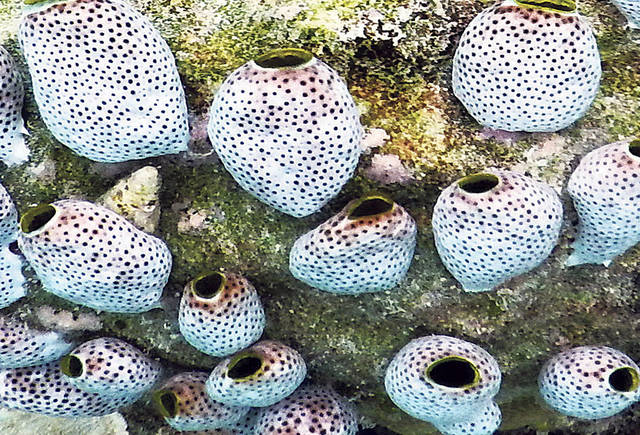Published in the Ocean Watch column, Honolulu Star-Advertiser © Susan Scott
March 4, 2017
I’m home from my snorkeling trips to Palau and Yap, and in sorting through my pictures, I came upon a favorite: something so new, I didn’t know whether it was plant or animal. When I showed the real thing to our knowledgeable Palauan guide, he didn’t know either, but guessed it was a kind of alga.
Soft, thimble-size barrels with pores in them didn’t look like any alga I had ever seen, but then, some weird plants grow in the world’s oceans. One common one looks like a small Japanese glass float that filled up with water and sank to the bottom. Some call this one-celled seaweed bubble algae. (Singular is alga, but no one calls it that.) I prefer its more colorful common name: sailor’s eyeball.
 More than 2,000 tunicate species are found throughout the world,
More than 2,000 tunicate species are found throughout the world,
with at least 45 varieties found in Hawaii. Pictured are the
green barrel sea squirt variety found in waters off Palau.
©2017 Susan Scott
After a few tries of describing my mystery organism, Google came up with “green barrel tunicate, scientific name, Didemnum molle” with a photo that matched mine.
Over 2,000 tunicate species are found throughout the world, with Hawaii hosting at least 45.
Years ago, in a zoology course at UH, I learned that these filter feeders have baglike bodies with two openings. One draws water in with tiny beating hairs, and the other directs water out. This human-heart-type image was the picture I had of all tunicates.
But like so many marine invertebrates, tunicates come in various forms. Some exist in colonies, where their bag bodies join at the base. The colonies can spread over coral and rocks in matlike patches with lots of inhalant and exhalant holes for sharing food. Often this spreading, combined with brilliant colors, makes some colonial tunicate species look like sponges.
The barrels in my photos are not visibly attached to one another, but runners creeping along the rock base connect individuals and give rise to new ones.
An individual green barrel sea squirt, also known as the tall urn ascidian (a class of tunicate), can grow to 4 inches in diameter in deep water. Shallow-water communities, such as those in my photos, are less than an inch wide.
The green tinge comes from a bacterium that lives in the tunicate’s tissues. Although not technically a plant, the bacteria produce oxygen, essential to the tunicate, the same way plants do, through photosynthesis. In this symbiotic relationship, the sea squirt produces a chemical sunscreen that protects its bacteria from UV radiation.
I’m not discouraged about not knowing those little barrels were sea squirts, or that I have surely incorrectly identified some tunicates as sponges. Learning new facts about the marine world is the thrill that keeps me dunking my face in water until it hurts.
Now I need to learn another fact: how one tells a tunicate from a sponge.